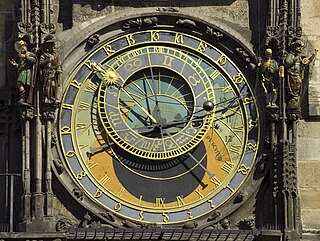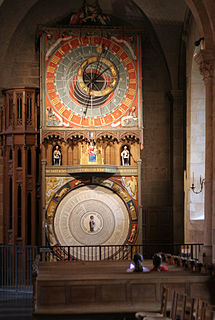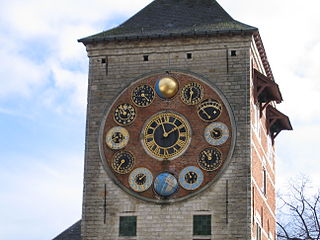 W
WAn astronomical clock, horologium, or orloj is a clock with special mechanisms and dials to display astronomical information, such as the relative positions of the sun, moon, zodiacal constellations, and sometimes major planets.
 W
WAn astrarium, also called a planetarium, is the mechanical representation of the cyclic nature of astronomical objects in one timepiece. It is an astronomical clock.
 W
WA Dar al-Muwaqqit, or muvakkithane in Turkish, is a room or structure accompanying a mosque which was used by the muwaqqit or timekeeper, an officer charged with maintaining the correct times of prayer and communicating them to the muezzin. Dar al-Muwaqqit was the Arabic term given to such structures added to many mosques in Morocco from the Marinid period onward. In the Ottoman Empire the equivalent of such structures were known in Turkish as a muvakkithane.
 W
WThe Gdańsk astronomical clock is a fifteenth-century astronomical clock in St. Mary's Church, Gdańsk.
 W
WJens Olsen's World Clock or Verdensur is an advanced astronomical clock which is displayed in Copenhagen City Hall.
 W
WLund astronomical clock, occasionally and at least since the 16th century referred to as Horologium mirabile Lundense, is a 15th-century astronomical clock in Lund Cathedral. Mentioned in written sources for the first time in 1442, it was probably made and installed sometime around 1423–25, possibly by Nikolaus Lilienfeld. It is part of a group of related medieval astronomical clocks found in the area around the south Baltic Sea. In 1837 the clock was dismantled. Between 1909 and 1923, it was restored by the Danish clockmaker Julius Bertram-Larsen and the Swedish architect responsible for the upkeep of the cathedral, Theodor Wåhlin. From the old clock, the face of the clock as well as the mechanism, which was largely replaced during the 18th century, was salvaged and re-used. The casing, most parts of the calendar which occupies the lower part, and the middle section were made anew.
 W
WThe Myriad year clock , was a universal clock designed by the Japanese inventor Hisashige Tanaka in 1851. It belongs to the category of Japanese clocks called Wadokei. This clock is designated as an Important Cultural Property and a Mechanical Engineering Heritage by the Japanese government.
 W
WA tellurion, is a clock, typically of French or Swiss origin, surmounted by a mechanism that depicts how day, night, and the seasons are caused by the rotation and orientation of Earth on its axis and its orbit around the Sun. The clock normally also displays the age of the Moon and the four-year (perpetual) calendar.
 W
WThe Zimmer tower is a tower in Lier, Belgium, also known as the Cornelius tower, that was originally a keep of Lier's 14th-century city fortifications. In 1930, astronomer and clockmaker Louis Zimmer (1888–1970) built the Jubilee Clock, which is displayed on the front of the tower, and consists of 12 clocks encircling a central one with 57 dials. These clocks showed time on all continents, phases of the moons, times of tides and many other periodic phenomena.